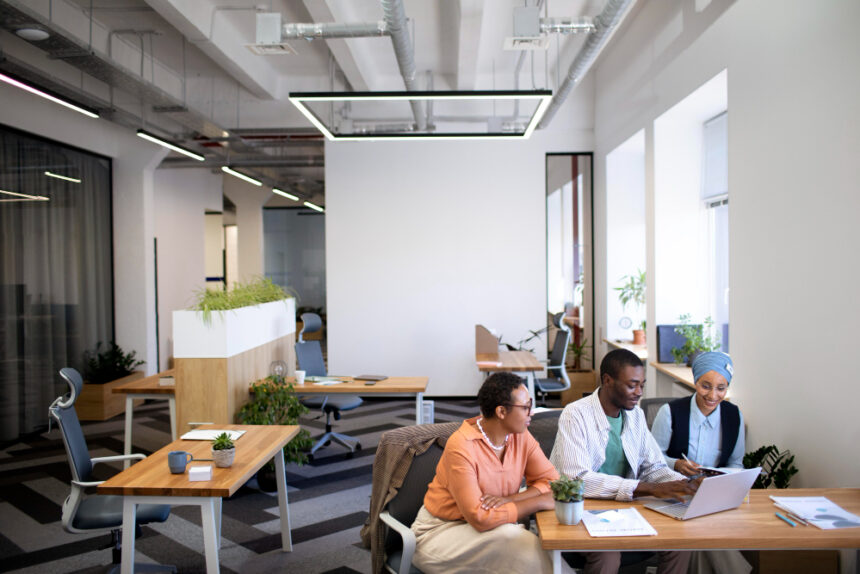Have you ever walked into an office and immediately felt a sense of energy, focus, and comfort? Do you wonder how some spaces manage to boost productivity with just the right blend of design, lighting, and equipment? It’s no secret that creating an engaging work environment can have a major impact on employee morale and company performance.
In this blog post, we’ll explore best practices for office fitouts in Melbourne, covering everything from budgeting and timelines to brand identity and wellbeing. You’ll learn how to plan an effective workspace, keep employees comfortable, and plan for future growth. We’ll also touch on some handy cost-saving tips, discuss Australian standards, and highlight the latest trends in local office design.
Introduction to Office Fitouts in Melbourne
Short of moving to a brand-new space, an office fitout is one of the most effective ways to breathe new life into your workplace. In Melbourne, the demand for innovative office fitouts has grown, thanks to a vibrant local business scene that thrives on creativity and community. Before diving too deep, it helps to understand what a fitout entails and why it’s so important.
Why Investing in a Well-Planned Office Fitout Matters
A well-planned office fitout does more than make your workspace look great. It can improve staff comfort, incorporate your brand identity, and provide the infrastructure your team needs to work productively. In fact, employees often feel more motivated when they see that management invests in a comfortable, balanced environment.
Overview of Melbourne’s Office Fitout Landscape
Melbourne is home to a diverse business community, and its office fitout industry keeps pace by offering a wide variety of services, styles, and solutions. From sleek and modern designs emphasising open-plan concepts, to more traditional layouts that celebrate privacy, you can find a wealth of inspiration across the city. Plus, local fitout companies in Melbourne are well-versed in Australian regulations and know how to navigate council approvals.
Initial Considerations for an Office Fitout
Planning is critical if you want your project to run smoothly, finish on time, and stay within budget. This stage sets the tone for your overall fitout experience. By plotting out costs, timelines, and regulatory requirements early, you’ll have a clear roadmap for bringing your vision to life.
Australian Standards and Regulations
Building codes, accessibility guidelines, and workplace health and safety regulations all play a part in shaping your office fitout. In Australia, compliance is non-negotiable. A reliable fitout specialist will approach these rules not as a headache but as an opportunity to ensure your workspace is safe and inclusive.
Assessing Space Requirements and Growth Projections
Fitting out your office doesn’t just address your current needs it should also allow for future expansion. Many businesses in Melbourne are dynamic, growing companies that might need more meeting rooms, collaborative corners, or private offices down the line. Think carefully about your growth trajectory.
Best Practices for Designing Your Office Fitout
With initial considerations out of the way, let’s look at how you can design an office that truly reflects your brand and supports your team’s day-to-day activities. From layout to technology, each decision can make a difference in both style and utility.
Planning the Layout and Floor Plan
Office design is not just about having enough desks. It’s about arranging workstations to enhance communication, teamwork, and comfort. Many Melbourne offices favour open layouts because they promote collaboration and shorten distances between teams. However, an entirely open-plan space might not work for every business.
Selecting Materials and Furniture for Durability and Comfort
Durability is crucial if you want your investment to stand the test of time. Since Melbourne’s weather can fluctuate quickly, choosing materials that adapt well—such as quality carpets that don’t fade is a good starting point. Similarly, selecting ergonomic chairs and desks helps curb back pain and other musculoskeletal issues.
Incorporating Brand Identity and Company Culture
Your workspace often speaks volumes about your organisation before anyone says a word. From the colour scheme to the display of company logos, you can use design elements to reinforce who you are and what you stand for. In Melbourne, where creativity flourishes, businesses often harness local art or unique décor to stand out.
Technology Integration and Future-Proofing Your Workspace
Australian workplaces are becoming more tech-focused every year. Ensuring your office fitout can accommodate new software, faster internet, and advanced collaboration tools keeps your team stay ahead of the curve. Future-proofing could mean installing extra data ports, wiring for video conferencing, or even planning spaces for augmented reality demonstrations.
Boosting Productivity and Employee Wellbeing
A well-designed office is one thing, but a space that truly empowers your team to do their best work is another. Productivity and wellbeing should always guide your decisions, especially in a demanding city like Melbourne, where employees expect modern, comfortable workplaces.
Lighting, Acoustics, and Air Quality
Lighting can influence everything from alertness to mood. Natural light is ideal, but not every Melbourne office is blessed with huge windows. In such cases, consider solutions that mimic daylight or use layered lighting techniques to avoid glare and eyestrain. Splashes of greenery or living walls also help clean the air and create a relaxing vibe.
Collaboration Spaces vs. Private Work Areas
Different tasks call for different settings. A bustling collaboration zone is fantastic for group projects, but individuals sometimes crave peace and quiet. Striking the balance between communal and private areas means your employees can choose the best environment for their approach to work.
Encouraging Creativity and Focus
If you want employees to think outside the box, you need an office that sparks ingenuity. Introducing playful elements—like whiteboard walls, comfy beanbags, or even interactive art—can shift the mind away from routine and into imaginative territory. In contrast, spaces designed for focus might feature minimal décor and subdued colours.
Cost-Saving Tips and Practical Insights
An office fitout can be an expensive endeavour, but there are plenty of ways to keep costs under control without sacrificing quality. By carefully planning your approach and taking advantage of local resources, you can enjoy a stylish new office that meets your budget goals.
Finding Low-Cost Alternatives and Reusing Existing Assets
Before you rush to buy all-new furniture, check what you already have. You might be surprised by how a fresh lick of paint or new upholstery can transform old pieces. If you do need to purchase new items, scout Melbourne’s thriving second-hand markets or liquidated office furniture sales for bargains.
Purchasing in bulk can also reduce costs, especially for items like desks or chairs. Consider your layout to avoid overspending on units you don’t need. By focusing on essential areas first, you can always add more elements later as funds allow.
Negotiating Contracts and Working with Local Suppliers
Local suppliers often understand Melbourne’s market conditions, which can lead to beneficial partnerships. They might offer flexible pricing, especially if you’re placing sizeable orders. Negotiating contracts can cut costs and align the timing of deliveries to suit your project schedule.
It’s also helpful to get multiple quotes and compare them. A more expensive contractor might end up cheaper in the long run if they have established supplier relationships and a proven track record. Consider factors like material warranties, timeline reliability, and the quality of labour.
Conclusion
Summing up, an office fitout in Melbourne is about more than just swapping old desks for new ones. It’s a chance to transform your space into a place where employees feel motivated, creativity thrives, and productivity stays high. By taking the time to plan carefully covering everything from budgeting and timelines to brand identity and sustainability you’ll be well on your way to a workspace that truly supports your goals.



